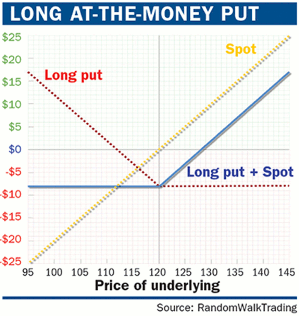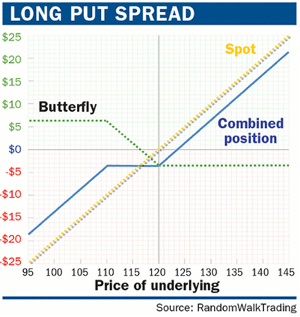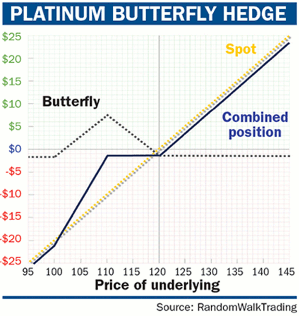For holders of physical gold who are getting increasingly nervous about its precipitous price drops, the staff at RandomWalkTrading offers three ways to hedge your position with options.
If you believe that no nation can become wealthier by going deeper in debt, then gold, silver, and platinum might be a viable hedge against the inevitable inflation that follows massive government infusions. Because investment metals can be cashed into any currency, they also are a hedge against a collapse of any nation’s currency.
However, even the most confident bull might be second guessing himself with recent price drops: From October 2012 to mid-July, gold has fallen from $1,800 per troy ounce to $1,200, a 33% plunge. Silver has fared worse, falling 50% in the same timeframe. So should you place a stop order and hope for the best? Should you dollar cost average and buy more, or take the loss and hope to get back in at even lower prices? That depends on your level of sophistication and the ultimate plans for your positions. If you are using precious metals as a life-hedge, you may not want to sell your coins, ingots, and bars. But just watching the metals and hoping for the best is not a game plan either.
Luckily, you can hedge a physical position with a wide variety of instruments. For gold there is the standard and mini-gold futures contracts, but a favorite is the SPDR Gold Trust ETF (GLD) because of the liquidity in the options. Say we have on a physical gold position of 10 ounces when it is trading for $1,228 (July 7) per oz. The GLD is trading at $119.51. One option contract protects 100 shares of the ETF, so this will be pretty close to a true dollar value hedge: the put will hedge $11,951 worth of gold (100x119.51). This is very close to our spot gold position of 10 coins trading at $1,228, or $12,280.
Many tools allow you to sleep at night regardless of what happens to the underlying price. The most common and expensive is purchasing a January 120 put for $8.00 that will adequately hedge the position. A thriftier option would be a $10 wide put spread (GLD 120-110 for $3.75), which protects about $100 range in the spot price, or gold going down to roughly $1,100. A GLD 120-110-100 put butterfly for $1.70 is even less expensive and also protects the spot all the way down to $1,100.
Below are three possibilities that can help you decide which hedge is the best based on your opinion of the spot price for the next six months and if you want to hold your physical metals. Spot gold price is represented by the yellowish-orange color line; the term “spot” is being used as the name for GLD.
3) Long at-the-money put: This hedge (represented by the dotted burgundy line) provides tight price loss scenario. The solid blue line represents both the price of your gold and the put hedge combined. 2) Long, put spread: This hedge, represented by a dotted green line, is a cheaper option.Click to Enlarge
3) Platinum butterfly hedge: This is for protecting the spot gold position that is to be held a long time. The butterfly hedge is in dotted black ink. And the hedge combined with the gold will be in blue.
(Note: Charts show options for the January 2014 expiry. The January 120 puts are $8. The 110 puts are $4.25, and the 100 puts are $2.20. Implied vol is 25.37 with 193 days remaining until expiration. GLD closed at 119.51, but the graph is centered at $120 to make the example easier to understand.).
By the Staff at RandomWalkTrading
























